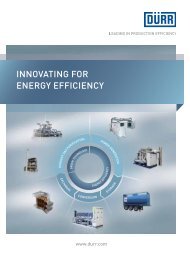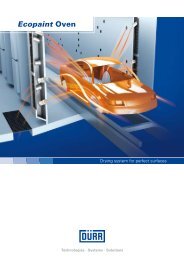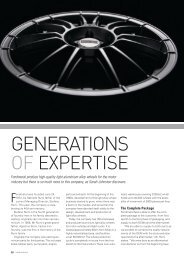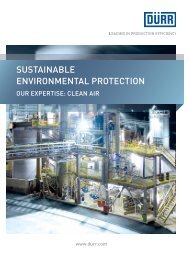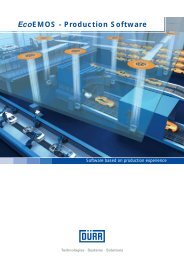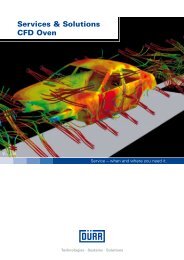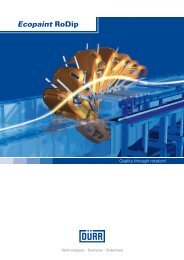DURR ECOdry Scrubber - IPCM novembre 2011.pdf
DURR ECOdry Scrubber - IPCM novembre 2011.pdf
DURR ECOdry Scrubber - IPCM novembre 2011.pdf
You also want an ePaper? Increase the reach of your titles
YUMPU automatically turns print PDFs into web optimized ePapers that Google loves.
INNOVATIONS: PRESENT&FUTURE<br />
The Status Quo<br />
When applying wet paints the efficiency varies<br />
depending on the level of automation. In manual<br />
painting 20% of the material reaches the body, while<br />
with automated exterior painting it is 85%. In the<br />
conventional painting process the rest of the paint,<br />
known as overspray, is carried into the lower section<br />
of the spray booth using downward flowing process<br />
air where it binds with water using special Venturi<br />
tubes. The booth process air is drawn off as, through<br />
contact with water it absorbs too much moisture for<br />
it to be re-used, and it also contains paint particle<br />
residues. The paint sludge resulting from the<br />
overspray mixed with water has to be disposed of as<br />
hazardous waste.<br />
The Idea<br />
The starting point for Dürr was to generate cost per<br />
unit advantages for the customer through reduced<br />
energy use. Eliminating the standard wet separation<br />
of excess paint particles that do not adhere to the<br />
car body surface means that fresh water is no longer<br />
required for paint separation. This in turn leads to<br />
the possibility of direct recirculation of the booth<br />
air since it does not accumulate any moisture.<br />
Recirculation reduces the energy required for air<br />
treatment significantly compared to conventional<br />
spray booths. This elimination of fresh water and<br />
the partial addition of fresh air leads to meaningful<br />
improvements in energy consumption and in CO 2 and<br />
paint particle emissions.<br />
Already at the beginning of 2005 the product<br />
developers at Dürr had the first thoughts about this<br />
system which is fully in fashion today. Particular<br />
challenges existed with the issues of complete<br />
automation, precoating and cleaning of the<br />
filters, as well as discharge and refilling of the<br />
precoat material. Then, after about two years of<br />
development time the Dürr pilot plant in Bietigheim<br />
started its operation in April 2007: it has already put<br />
in over 1,500 hours of operation to date.<br />
The Technology<br />
For dry separation Dürr replaced water with<br />
powdered limestone as a bonding agent. This<br />
precoat material comes from silos or big-bag stations<br />
in the separation process. The dry filter modules<br />
consist of process-optimized filter elements which<br />
regenerate automatically during operation and can<br />
Lo status quo<br />
Quando si applica vernice liquida, l’efficienza varia a seconda<br />
del livello di automazione. Nella verniciatura manuale<br />
il 20% del materiale raggiunge la scocca, mentre<br />
con la verniciatura automatica esterna è l’ 85%. Nel processo<br />
di verniciatura tradizionale l’eccesso di vernice, conosciuto<br />
come overspray, è convogliato nella parte più<br />
bassa della cabina di verniciatura tramite l’aria di processo;<br />
questa fluisce verso il basso e qui si unisce all’acqua<br />
utilizzando speciali tubi Venturi. L’aria di processo della cabina<br />
è poi espulsa dal momento che, a causa del contatto<br />
con l’acqua, assorbe troppa umidità per essere riutilizzata,<br />
e inoltre contiene residui di vernice. I fanghi di vernice<br />
che risultano dall’overspray miscelato con l’acqua devono<br />
essere smaltiti come rifiuti pericolosi.<br />
L’idea<br />
Il punto di partenza per Dürr era creare vantaggi di<br />
costo per unità al cliente attraverso la riduzione del<br />
consumo di energia. Eliminando la separazione umida<br />
tradizionale della vernice in eccesso che non aderisce<br />
alla superficie della scocca dell’auto significa che<br />
non si ha più la necessità di acqua dolce per la separazione<br />
della vernice. Al contrario questo consente<br />
il ricircolo diretto dell’aria della cabina siccome essa<br />
non accumula più alcuna umidità. Il ricircolo riduce<br />
in modo significativo l’energia richiesta per il trattamento<br />
dell’aria, se comparata alle cabine tradizionali<br />
di spruzzatura. L’eliminazione dell’acqua dolce e la<br />
parziale aggiunta di aria nuova porta importanti miglioramenti<br />
nel consumo di energia e nelle emissioni<br />
di CO 2 e di particelle di vernice.<br />
Già all’inizio del 2005 gli sviluppatori del prodotto c/o<br />
Dürr ebbero la prima idea riguardo a questo sistema,<br />
oggi molto di moda. Il tema dell’automazione completa,<br />
il precoating e la pulizia dei filtri, così come lo<br />
scarico e il ricarico del materiale di precoat rappresentavano<br />
delle vere e proprie sfide. Dopo circa due<br />
anni di sviluppo, l’impianto pilota Dürr a Bietigheim<br />
iniziò a funzionare nell’aprile del 2007 e oggi funziona<br />
già da oltre 1.500 ore.<br />
La tecnologia<br />
Per la separazione a secco Dürr ha sostituito l’acqua con<br />
calcare polveroso come agente legante. Questo materiale<br />
di precoat arriva al processo di separazione da silos o centrali<br />
big-bag. I moduli di filtrazione a secco consistono di<br />
elementi filtranti ottimizzati per il processo che si rigenerano<br />
automaticamente durante il funzionamento e possono<br />
international PAINT&COATING magazine - NOVEMBER/<strong>novembre</strong> 2011 - N. 12 53



